- Joined
- Feb 2, 2011
- Messages
- 2,379
THE AMERICAN CIVIL WAR
THE BATTLE OF BRANDY STATION, JUNE 9th, 1863
THE ARMY OF THE POTOMAC, CAVALRY CORPS
The high ground on the farm of Richard Cunningham served as wing commander Brig. Gen. John Buford’s command post for much of the battle. Cavalry corps commander Alfred Pleasonton also observed the fighting from this area. Custer, an aide to Pleasonton was spotted here during the afternoon phase of the engagement.
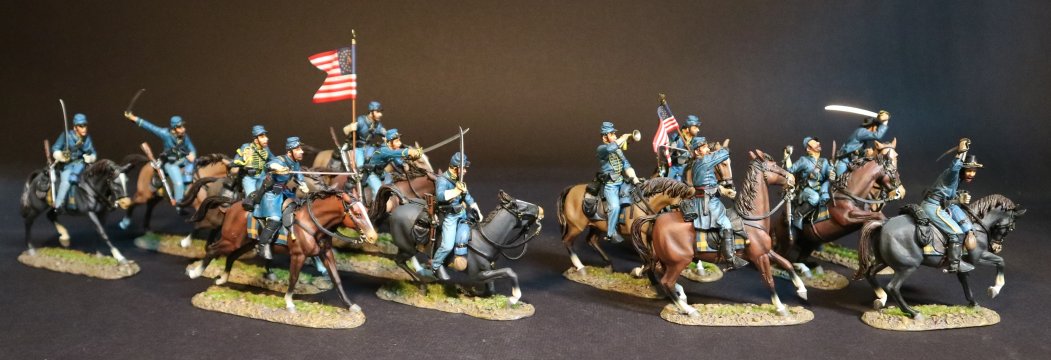
Daniel Oakey was an officer in the 2nd Massachusetts Infantry, which made up Brig. Gen. Adelbert Ames’ demi-brigade that supported Pleasonton’s horse soldiers.
“Having nothing to do as yet but smoke our pipes, we lolled on the grass and studied our cavalry friends”, Oakey recalled. “Custer was the most striking of the group with…his long hair, and spirited manner. He seemed to enjoy the shelling, and appeared to beam all over, almost dancing with excitement.”
When Buford called on the Bay Staters to dislodge elements of Brig. Gen. W.H.F. “Rooney” Lee’s brigade at a stonewall at the knoll’s western base, Oakey wrote that “Custer showed much interest” in accompanying them and “evidently would have enjoyed going with us.” The young officer, however, remained behind with Pleasonton.
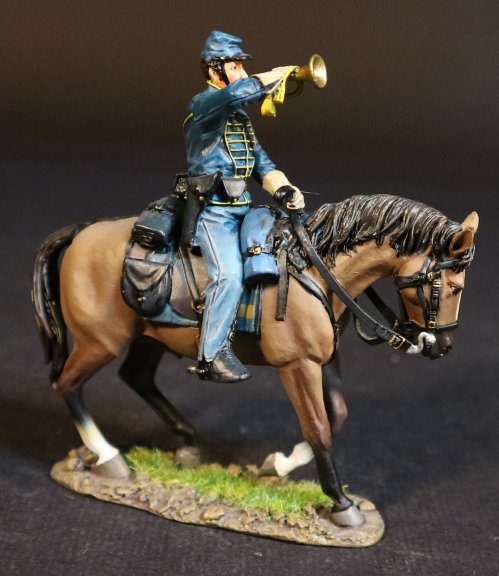
USBS-16
THE AMERICAN CIVIL WAR 1861 - 1865
THE BATTLE OF BRANDY STATION, JUNE 9th, 1863,
THE ARMY OF THE POTOMAC,
CAVALRY CORPS,
UNION CAVALRY
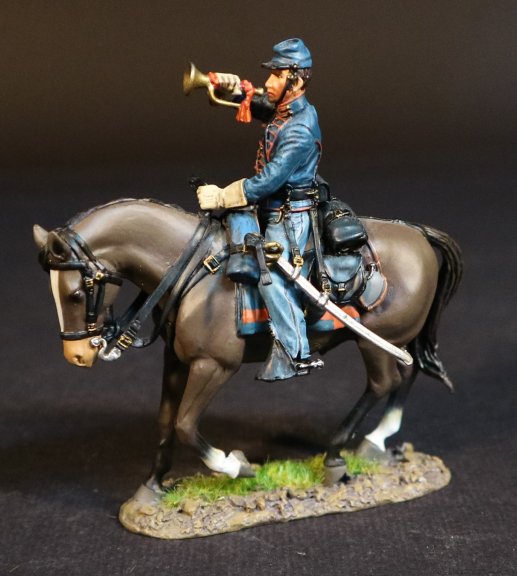
USBS2-16
THE AMERICAN CIVIL WAR 1861 - 1865
THE BATTLE OF BRANDY STATION, JUNE 9th, 1863,
THE ARMY OF THE POTOMAC,
CAVALRY CORPS,
2nd US CAVALRY REGIMENT
THE ARMY OF NORTHERN VIRGINIA, CAVALRY DIVISION,
CONFEDERATE CAVALRY
The Battle of Brandy Station saw nine thousand Union cavalrymen and three thousand Union infantry clash with ten thousand Confederate horsemen. The fighting lasted for roughly twelve hours and covered dozens of square miles.
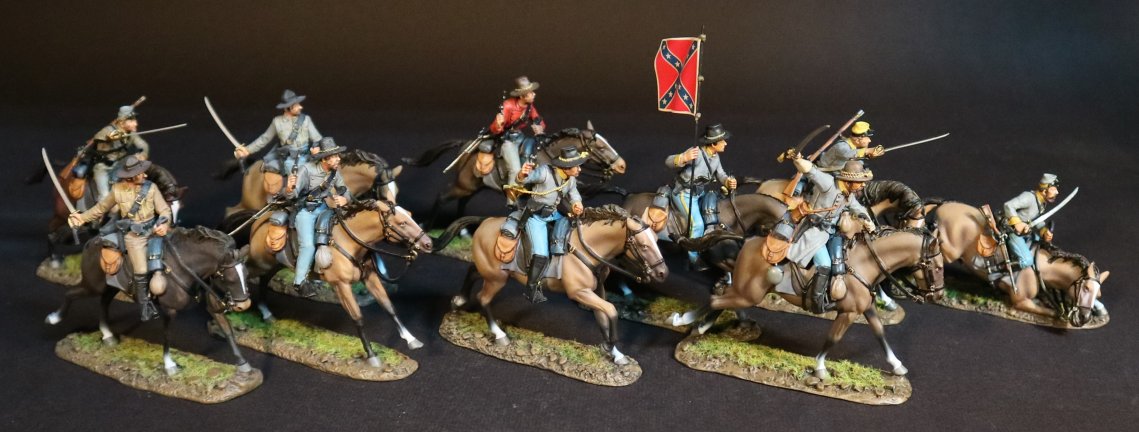
Unknown to the Confederates, 12,000 Union men had massed on the other side of the Rappahannock River.
Maj. Gen. Alfred Pleasonton, commanding the Cavalry Corps of the Army of The Potomac, had organized his combined armed forces into two wings, under Brig. Gen. John Buford and David McMurtrie Gregg, augmented by infantry brigades from the V Corps.
Buford’s wing, accompanied by Pleasonton, consisted of his own 1st Cavalry Division, a reserve brigade led by Maj. Charles J. Whiting, and an infantry brigade of 3,000 men under Brig. Gen. Adelbert Ames.
Gregg’s wing was the 2nd Cavalry Division, led by Col. Alfred N. Duffie, the 3rd Cavalry Division led by Gregg, and an infantry brigade under Brig. Gen. David A. Russell.
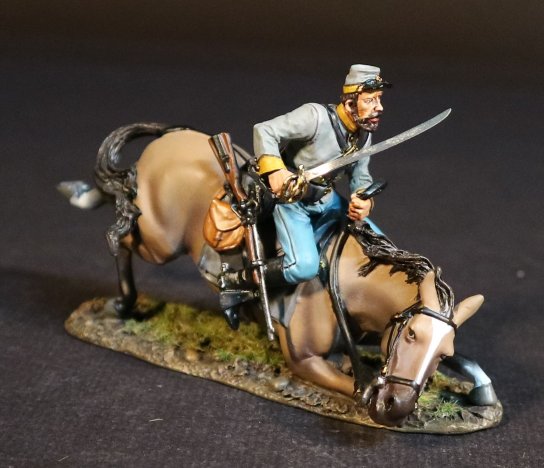
CSBS-04A
THE AMERICAN CIVIL WAR 1861 - 1865
THE BATTLE OF BRANDY STATION, JUNE 9th, 1863,
THE ARMY OF NORTHERN VIRGINIA,
CAVALRY DIVISION,
CONFEDERATE CAVALRYMAN
The commander of the Army of the Potomac, Maj. Gen. Joseph Hooker, interpreted the enemy’s cavalry presence around Culpeper to be indicative of preparations for a raid of his army’s supply lines. In reaction to this, he ordered Pleasonton’s force on a “spoiling raid”, to “disperse and destroy” the Confederates.
Pleasonton’s attack plan called for a two-pronged thrust at the enemy. Buford’s wing would cross the river at Beverly’s Ford, two miles northeast of Brandy Station, at the same time, Gregg would cross at Kelly’s Ford, six miles downstream to the southeast.
Pleasonton anticipated that the Southern cavalry would be caught in a double envelopment, surprised, outnumbered, and beaten.
He was, however, unaware of the precise disposition of the enemy and he incorrectly assumed that his force was substantially larger than the Confederates he faced.
Both sides at Brandy Station were armed in a similar manner. For mounted combat, cavalrymen carried light cavalry sabers and pistols. Some Confederate cavalry carried more than one pistol, or a shotgun, and basically used what they could get a hold of.
In a melee or skirmish, there was no intrinsic superiority of pistol over a saber. Even an excellent shot found hitting a moving mounted enemy target difficult, and sabers had the advantage they did not need to be reloaded. The saber had the advantage of intimidation during a charge, with many defenders breaking when faced by a crowd of riders waving sabers, even before the charging troops reached them.
A typical cavalry charge against cavalry was a relatively rare occurrence, usually with one side or the other breaking and bolting before contact. If hand to hand combat ensued, the fighting was confusing, vicious and protracted. If one side committed reserve squadrons to the fray, they often carried the day.
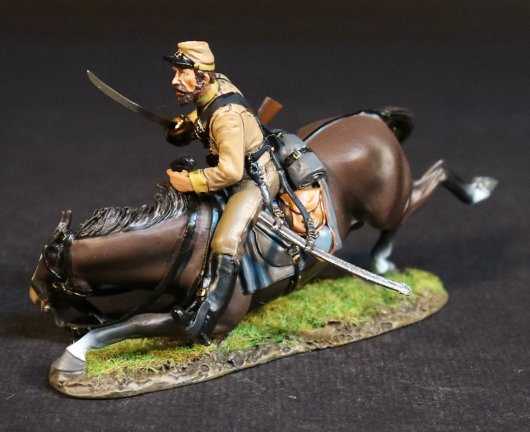
CSBS-04B
THE AMERICAN CIVIL WAR 1861 - 1865
THE BATTLE OF BRANDY STATION, JUNE 9th, 1863,
THE ARMY OF NORTHERN VIRGINIA,
CAVALRY DIVISION,
CONFEDERATE CAVALRYMAN
THE FIRST BATTLE OF MANASSAS, 1861.
1st SPECIAL BATTALION, LOUISIANA INFANTRY (WHEAT’S TIGERS)

The battalion called the Louisiana Tigers was the creation of Roberdeau Chatham Wheat, and was to become one of the most notorious military corps ever to be raised during this conflict.
In New Orleans Wheat looked for his recruits among the Irish roustabouts and riffraff of the city.
His company was soon joined by four others and on June 9th 1861, they were mustered into the Confederate service as the 1st Louisiana Special Battalion.
The battalion soon gained a fine reputation for brawling and theft!
In action finally at the First Manassas, the Tigers showed they could also fight in battle.
An English observer wrote, “Although few in number these heroic soldiers sustained every shock with unwavering courage, and on more than one occasion dropped their rifles and rushed among the enemy with long bowie knives.”
Wheat, brave to the point of recklessness was killed 27th June 1862 at Gaines’ Mill. For the first time the battalion broke and ran. With Wheat gone there was no one to keep the Tigers in hand and on 21st August the battalion was disbanded and its men transferred to other Louisiana regiments serving in Virginia.
The name “Louisiana Tigers” however lived on to describe the Louisiana Brigade as it fought through to Appomattox.
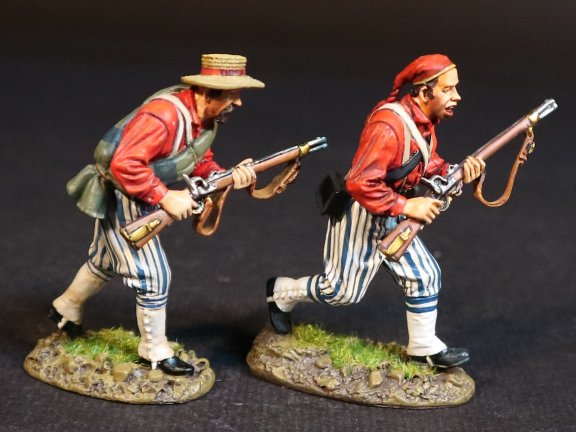
CSWT-05
THE AMERICAN CIVIL WAR 1861 - 1865
THE FIRST BATTLE OF MANASSAS, 1861
1st SPECIAL BATTALION, LOUISIANA INFANTRY,
(WHEAT’S TIGERS)
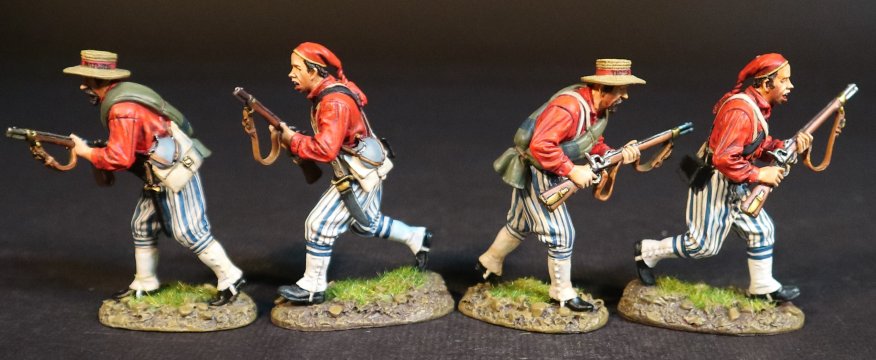
CSWT-05N
THE AMERICAN CIVIL WAR 1861 - 1865
THE FIRST BATTLE OF MANASSAS, 1861
1st SPECIAL BATTALION, LOUISIANA INFANTRY,
(WHEAT’S TIGERS)
THE FIRST BATTLE OF BULL RUN 1861.
1st REGIMENT, RHODE ISLAND DETACHED MILITIA, 1861
In the days following the outbreak of war, Northern states scrambled to assemble small militia groups into regiment-size units, recruit additional volunteers and uniform them all in a cohesive manner. Rhode Island was no exception with the added problem of having no official state uniform for its troops. Ambrose Everett Burnside, former major general in the state’s militia, returned from his job as a N.Y. City banker and stepped up to the task of equipping and organizing the troops.

On April 20, just five days from Lincoln’s call for 75,000 troops for three months service, the First Rhode Island Detached Militia departed for Washington D.C., led by Col. Burnside himself. On July 16 the unit left camp outside the capital with the bulk of the Union Army and five days later met the Confederate forces at Manassas, Va.
With summer approaching, and expectations that the war would be short, uniforms were lightweight, with little attention to durability. Designed by Col. Burnside and inspired by the “hunting shirts” worn by many Continentals during the American Revolution, the blue flannel pullover blouse was simple and easily made by the ladies in Providence. Single breasted for line officers and enlistees, double breasted for staff.
The most distinguishing item of gear was a bright red woolen blanket. Burnside personally superintended the manufacture of the uniform,
“He had the thick scarlet blanket of each man converted into a Mexican poncho, by cutting a slit in the centre through which the head could be put, leaving the blanket resting as a cloak on the shoulders”.
A waistbelt with cartridge box and cap box, a white canvas haversack for rations and a tin canteen completed the kit.
The Regiment served in Burnside’s Brigade at First Bull Run, taking an early part in the action. For a time it stood up well, but after two or three hours of heat and combat it fell to pieces and was of little value afterwards
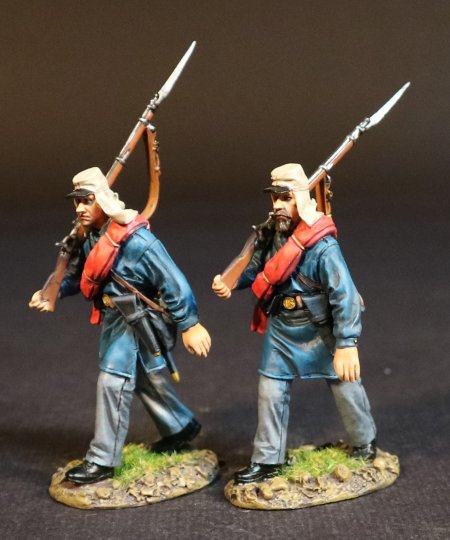
1RH-07
THE AMERICAN CIVIL WAR 1861 - 1865
THE FIRST BATTLE OF BULL RUN, 1861
1st REGIMENT, RHODE ISLAND DETACHED MILITIA, 1861
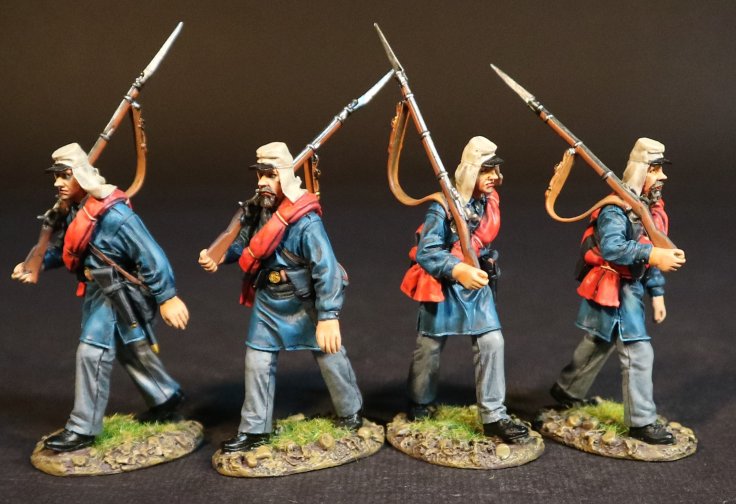
1RH-07N
THE AMERICAN CIVIL WAR 1861 - 1865
THE FIRST BATTLE OF BULL RUN, 1861
1st REGIMENT, RHODE ISLAND DETACHED MILITIA, 1861
**PLEASE CONTACT YOUR LOCAL DEALER TO PLACE YOUR PRE-ORDERS**
THE BATTLE OF BRANDY STATION, JUNE 9th, 1863
THE ARMY OF THE POTOMAC, CAVALRY CORPS
The high ground on the farm of Richard Cunningham served as wing commander Brig. Gen. John Buford’s command post for much of the battle. Cavalry corps commander Alfred Pleasonton also observed the fighting from this area. Custer, an aide to Pleasonton was spotted here during the afternoon phase of the engagement.

Daniel Oakey was an officer in the 2nd Massachusetts Infantry, which made up Brig. Gen. Adelbert Ames’ demi-brigade that supported Pleasonton’s horse soldiers.
“Having nothing to do as yet but smoke our pipes, we lolled on the grass and studied our cavalry friends”, Oakey recalled. “Custer was the most striking of the group with…his long hair, and spirited manner. He seemed to enjoy the shelling, and appeared to beam all over, almost dancing with excitement.”
When Buford called on the Bay Staters to dislodge elements of Brig. Gen. W.H.F. “Rooney” Lee’s brigade at a stonewall at the knoll’s western base, Oakey wrote that “Custer showed much interest” in accompanying them and “evidently would have enjoyed going with us.” The young officer, however, remained behind with Pleasonton.

USBS-16
THE AMERICAN CIVIL WAR 1861 - 1865
THE BATTLE OF BRANDY STATION, JUNE 9th, 1863,
THE ARMY OF THE POTOMAC,
CAVALRY CORPS,
UNION CAVALRY

USBS2-16
THE AMERICAN CIVIL WAR 1861 - 1865
THE BATTLE OF BRANDY STATION, JUNE 9th, 1863,
THE ARMY OF THE POTOMAC,
CAVALRY CORPS,
2nd US CAVALRY REGIMENT
THE ARMY OF NORTHERN VIRGINIA, CAVALRY DIVISION,
CONFEDERATE CAVALRY
The Battle of Brandy Station saw nine thousand Union cavalrymen and three thousand Union infantry clash with ten thousand Confederate horsemen. The fighting lasted for roughly twelve hours and covered dozens of square miles.

Unknown to the Confederates, 12,000 Union men had massed on the other side of the Rappahannock River.
Maj. Gen. Alfred Pleasonton, commanding the Cavalry Corps of the Army of The Potomac, had organized his combined armed forces into two wings, under Brig. Gen. John Buford and David McMurtrie Gregg, augmented by infantry brigades from the V Corps.
Buford’s wing, accompanied by Pleasonton, consisted of his own 1st Cavalry Division, a reserve brigade led by Maj. Charles J. Whiting, and an infantry brigade of 3,000 men under Brig. Gen. Adelbert Ames.
Gregg’s wing was the 2nd Cavalry Division, led by Col. Alfred N. Duffie, the 3rd Cavalry Division led by Gregg, and an infantry brigade under Brig. Gen. David A. Russell.

CSBS-04A
THE AMERICAN CIVIL WAR 1861 - 1865
THE BATTLE OF BRANDY STATION, JUNE 9th, 1863,
THE ARMY OF NORTHERN VIRGINIA,
CAVALRY DIVISION,
CONFEDERATE CAVALRYMAN
The commander of the Army of the Potomac, Maj. Gen. Joseph Hooker, interpreted the enemy’s cavalry presence around Culpeper to be indicative of preparations for a raid of his army’s supply lines. In reaction to this, he ordered Pleasonton’s force on a “spoiling raid”, to “disperse and destroy” the Confederates.
Pleasonton’s attack plan called for a two-pronged thrust at the enemy. Buford’s wing would cross the river at Beverly’s Ford, two miles northeast of Brandy Station, at the same time, Gregg would cross at Kelly’s Ford, six miles downstream to the southeast.
Pleasonton anticipated that the Southern cavalry would be caught in a double envelopment, surprised, outnumbered, and beaten.
He was, however, unaware of the precise disposition of the enemy and he incorrectly assumed that his force was substantially larger than the Confederates he faced.
Both sides at Brandy Station were armed in a similar manner. For mounted combat, cavalrymen carried light cavalry sabers and pistols. Some Confederate cavalry carried more than one pistol, or a shotgun, and basically used what they could get a hold of.
In a melee or skirmish, there was no intrinsic superiority of pistol over a saber. Even an excellent shot found hitting a moving mounted enemy target difficult, and sabers had the advantage they did not need to be reloaded. The saber had the advantage of intimidation during a charge, with many defenders breaking when faced by a crowd of riders waving sabers, even before the charging troops reached them.
A typical cavalry charge against cavalry was a relatively rare occurrence, usually with one side or the other breaking and bolting before contact. If hand to hand combat ensued, the fighting was confusing, vicious and protracted. If one side committed reserve squadrons to the fray, they often carried the day.

CSBS-04B
THE AMERICAN CIVIL WAR 1861 - 1865
THE BATTLE OF BRANDY STATION, JUNE 9th, 1863,
THE ARMY OF NORTHERN VIRGINIA,
CAVALRY DIVISION,
CONFEDERATE CAVALRYMAN
THE FIRST BATTLE OF MANASSAS, 1861.
1st SPECIAL BATTALION, LOUISIANA INFANTRY (WHEAT’S TIGERS)

The battalion called the Louisiana Tigers was the creation of Roberdeau Chatham Wheat, and was to become one of the most notorious military corps ever to be raised during this conflict.
In New Orleans Wheat looked for his recruits among the Irish roustabouts and riffraff of the city.
His company was soon joined by four others and on June 9th 1861, they were mustered into the Confederate service as the 1st Louisiana Special Battalion.
The battalion soon gained a fine reputation for brawling and theft!
In action finally at the First Manassas, the Tigers showed they could also fight in battle.
An English observer wrote, “Although few in number these heroic soldiers sustained every shock with unwavering courage, and on more than one occasion dropped their rifles and rushed among the enemy with long bowie knives.”
Wheat, brave to the point of recklessness was killed 27th June 1862 at Gaines’ Mill. For the first time the battalion broke and ran. With Wheat gone there was no one to keep the Tigers in hand and on 21st August the battalion was disbanded and its men transferred to other Louisiana regiments serving in Virginia.
The name “Louisiana Tigers” however lived on to describe the Louisiana Brigade as it fought through to Appomattox.

CSWT-05
THE AMERICAN CIVIL WAR 1861 - 1865
THE FIRST BATTLE OF MANASSAS, 1861
1st SPECIAL BATTALION, LOUISIANA INFANTRY,
(WHEAT’S TIGERS)

CSWT-05N
THE AMERICAN CIVIL WAR 1861 - 1865
THE FIRST BATTLE OF MANASSAS, 1861
1st SPECIAL BATTALION, LOUISIANA INFANTRY,
(WHEAT’S TIGERS)
THE FIRST BATTLE OF BULL RUN 1861.
1st REGIMENT, RHODE ISLAND DETACHED MILITIA, 1861
In the days following the outbreak of war, Northern states scrambled to assemble small militia groups into regiment-size units, recruit additional volunteers and uniform them all in a cohesive manner. Rhode Island was no exception with the added problem of having no official state uniform for its troops. Ambrose Everett Burnside, former major general in the state’s militia, returned from his job as a N.Y. City banker and stepped up to the task of equipping and organizing the troops.

On April 20, just five days from Lincoln’s call for 75,000 troops for three months service, the First Rhode Island Detached Militia departed for Washington D.C., led by Col. Burnside himself. On July 16 the unit left camp outside the capital with the bulk of the Union Army and five days later met the Confederate forces at Manassas, Va.
With summer approaching, and expectations that the war would be short, uniforms were lightweight, with little attention to durability. Designed by Col. Burnside and inspired by the “hunting shirts” worn by many Continentals during the American Revolution, the blue flannel pullover blouse was simple and easily made by the ladies in Providence. Single breasted for line officers and enlistees, double breasted for staff.
The most distinguishing item of gear was a bright red woolen blanket. Burnside personally superintended the manufacture of the uniform,
“He had the thick scarlet blanket of each man converted into a Mexican poncho, by cutting a slit in the centre through which the head could be put, leaving the blanket resting as a cloak on the shoulders”.
A waistbelt with cartridge box and cap box, a white canvas haversack for rations and a tin canteen completed the kit.
The Regiment served in Burnside’s Brigade at First Bull Run, taking an early part in the action. For a time it stood up well, but after two or three hours of heat and combat it fell to pieces and was of little value afterwards

1RH-07
THE AMERICAN CIVIL WAR 1861 - 1865
THE FIRST BATTLE OF BULL RUN, 1861
1st REGIMENT, RHODE ISLAND DETACHED MILITIA, 1861

1RH-07N
THE AMERICAN CIVIL WAR 1861 - 1865
THE FIRST BATTLE OF BULL RUN, 1861
1st REGIMENT, RHODE ISLAND DETACHED MILITIA, 1861
**PLEASE CONTACT YOUR LOCAL DEALER TO PLACE YOUR PRE-ORDERS**

